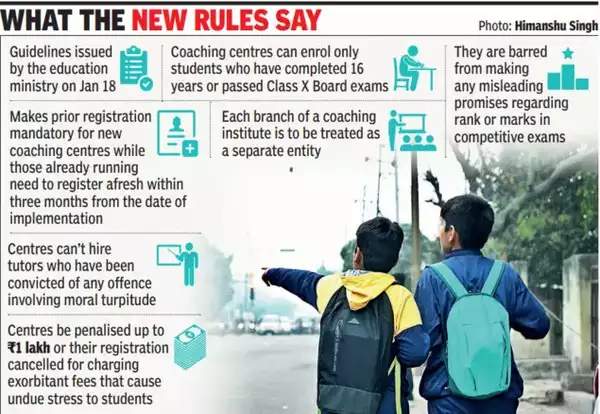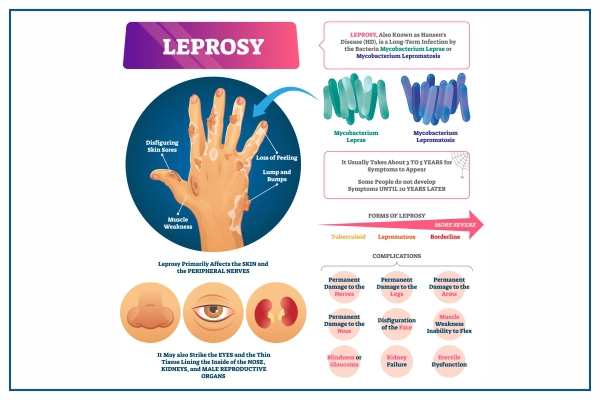1. "Why It Is Imperative to Regulate India's Proliferation of Coaching Centers?"
Introduction
- Recent governmental directives aimed at overseeing the coaching industry have triggered discussions and raised concerns regarding the state of education in India.
- Here we will explore the rationale behind these guidelines and their potential ramifications for various stakeholders.
Examining Coaching Challenges
- Elimination of Early Enrollment: According to the government’s guidelines, students below the age of 16 are prohibited from enrolling in coaching centers, confining admission eligibility to post-secondary school (standard 10) examinations.
- Educational Landscape Shift: This directive has sparked worry, given that coaching centers have transformed into an alternative educational route. Preparing 10 to 12-year-old students for highly competitive exams, such as those in engineering, medicine, and civil services, with notably low success rates, has become a cause for concern.
- Proliferation of Coaching Centers: States like Bihar, Rajasthan, Delhi, and Uttar Pradesh exhibit a notable prevalence of coaching centers.
Regulatory Necessity: Why?
- Escalation in Student Suicides: The alarming surge in student suicides, with Kota reporting 26 cases in 2023 alone, underscores the tremendous pressure on schoolchildren.
- Government’s Concerns: The Department of Higher Education, operating under the Ministry of Education, has emphasized the necessity for regulations in response to issues like student suicides, fire incidents, inadequate facilities, and teaching methodologies.
Rise of ‘Dummy Schools’: The emergence of ‘dummy schools’ associated with coaching centers, where physical attendance is not mandatory, has raised alarms. Parents frequently uproot their families and incur loans to relocate to coaching hubs in pursuit of quality education.
Broader Impacts: Who Else Will Feel the Effects?
- Ecosystem Consequences: Coaching hubs like Kota have an entire ecosystem supporting institutes, students, and families, including intermediaries, hostels, and hotels—all of which may face losses.
- Real Estate Impacts: Families moving to coaching hubs contribute to local real estate revenue, a facet that may be affected by the regulations.
- Effect on ‘Dummy Schools’: New regulations are likely to lead to the closure of ‘dummy schools.’
Insights from Coaching Centers
- Coaching Federation of India’s Stand: The Coaching Federation of India (CFI), representing over 25,000 coaching institutes, may legally challenge the minimum age requirement, advocating for a reduction from 16 years to 12 years.
- Worries About Competitive Stress: Larger coaching institutes express concerns that the regulations could heighten competitive stress among students, allowing them less time for preparation.
- Doubts Regarding Regulatory Efficacy: Some fear that the regulations may struggle to oversee smaller private coaching centers, making it difficult to monitor smaller establishments.
Education’s Interconnected Nature
- Coaching Dependency: The guidelines shed light on the prevalent dependence on coaching institutes, which supplement students’ regular schooling and often demand additional study hours outside the classroom.
- Deceptive Assurances: The guidelines also emphasize how institutes occasionally make misleading promises or guarantee high scores, emphasizing that ranks and marks have overshadowed holistic student development.
Conclusion
The recent governmental guidelines have sparked a crucial conversation about the coaching industry and its role in the Indian education system. These regulations aim to address pressing concerns while recognizing the evolving dynamics of education in the country.
2. Advancing Leprosy Eradication: India's New Treatment Regimen
Introduction:
In a noteworthy development, the Health Ministry has implemented a novel treatment plan for leprosy, aiming to halt its spread at the sub-national level by 2027. This effort is in line with the UN’s Sustainable Development Goals, advancing the target by three years.
Treatment Regimen Update:
The Ministry of Health and Family Welfare has approved a three-drug treatment plan for Pauci-Bacillary (PB) cases, supplanting the current six-month, two-drug regimen. This decision is grounded in recent global scientific research and evidence-based practices.
Implementation Timeline and WHO’s Commitment:
- The World Health Organization (WHO) has pledged to supply the updated drug regimen from April 1, 2025. States and Union Territories are encouraged to request anti-leprosy drugs a year in advance.
- Simultaneously, the revised classification of leprosy and the treatment regimen for PB and multi-bacillary (MB) cases in India will come into effect.
Controversy Surrounding Third Drug:
- Despite the efficacy of the existing two-drug regimen, the introduction of a third drug, clofazamine, has been met with some questioning.
- Healthcare experts point out that the two-drug regimen is already effective, and the third drug may introduce additional side effects.
Understanding Leprosy:
- Leprosy, caused by Mycobacterium leprae bacteria, is a chronic infectious disease impacting the skin and peripheral nerves.
- If left untreated, it can lead to permanent disabilities.
- The bacteria spread through droplets from the nose and mouth during close contact.
- Multi-drug therapy (MDT), consisting of dapsone, rifampicin, and clofazimine, is recommended by the WHO for curing leprosy.
Rationale Behind Three-Drug Regimen:
- PB patients exhibit fewer visible bacteria and show no signs of advanced disease in biopsies, while MB patients have visible bacteria and may display indications of more advanced disease.
The new treatment regimen is seen as a significant stride towards achieving the collective goal of eradicating leprosy in India by 2027.
3. Exploring the Discourse on the K-Shaped Economic Recovery: An In-Depth Examination of SBI Research
Introduction
The Economic Research Department of the State Bank of India (SBI) recently unveiled a study titled “Debunking K-shaped recovery,” addressing the ongoing discourse surrounding India’s post-pandemic recovery and its purported K-shaped characteristics.
Understanding K-Shaped Recovery
- A K-shaped recovery transpires when distinct segments of the economy recuperate disparately in terms of rates, timing, or magnitudes, as opposed to a uniform resurgence across sectors, industries, or demographic groups.
- Such a recovery reshapes the economic structure and societal dynamics, causing fundamental changes in economic outcomes and relationships pre- and post-recession.
- The term “K-shaped” is employed because, when plotted, the trajectories of different economic segments may diverge, resembling the two arms of the Roman letter “K.”
SBI’s Challenge to Conventional Views
- Contentious Message: The central message of the report intimates a potential “conspiracy” against India’s growth, casting doubt on the credibility and motives behind the economic evaluation.
- Summary of the Message: It questions the legitimacy of the K-shaped recovery concept, deeming it “flawed” and influenced by specific vested interests uncomfortable with India’s ascendancy on the global stage.
Reassessing Economic Well-Being
- Scrutinized Parameters: The report challenges conventional indicators used to gauge economic well-being.
- Novel Considerations: It underscores patterns in income, savings, consumption, expenditure, and technology-driven policy measures designed to empower the masses, while questioning reliance on outdated metrics like 2-wheeler sales or land holdings.
Crafting a Narrative
- Polarized Climate: In a period of heightened polarization and India’s elevation as a major economy, the report’s language, with phrases like “fanning interests” and “renaissance of the new global south,” seems to align with current political narratives.
- Shift in Narrative: The report introduces an alternative narrative, accentuating the reduction of inequality in India.
Contentions Regarding Inequality
- Assertion of Inequality Reduction: The report contends that income inequality has diminished, citing the Gini coefficient of taxable income, which declined from 0.472 to 0.402 between FY14 and FY22.
- Limited Sample Concerns: However, the reliance on “taxable income” from a small fraction (around 5%) of the population, mainly income tax payers, raises questions about its representativeness of the informal workforce and broader economy.
- Proxy Utilization: The study employs Zomato food orders, primarily from semi-urban areas, to challenge assertions of economic distress.
Concerns about Representativeness
- Focus on the Formal Sector: SBI’s research predominantly focuses on the formal sector, representing a privileged minority within the Indian economy.
- Inequality Debate Reflection: This focus aligns with the core of the inequality debate, where those excluded from economic growth lag behind, while the affluent experience significant progress.
An Alternate Viewpoint
- Diverging Reports: In 2022, another report, “The State of Inequality in India,” commissioned by the Economic Advisory Council to the Prime Minister, highlighted escalating inequality in the country.
- Noteworthy Disparities: It revealed that an individual earning a monthly wage of Rs 25,000 was among the top 10% of earners, underscoring profound income disparities.
Conclusion
While the SBI research presents a distinctive viewpoint on India’s economic recovery and inequality, its concentration on a limited formal sector sample raises concerns about its representativeness. The broader discourse on inequality remains crucial, emphasizing the imperative for a more comprehensive understanding of the diverse economic landscape in India.
4. Expansion of BSF's Jurisdiction: The Challenge and Implications for Punjab
Introduction:
In October 2021, a significant decision was made by the Ministry of Home Affairs to extend the jurisdiction of the Border Security Force (BSF) in certain states.
This move has led to a legal dispute between the central government and the affected states. This editorial examines the recent developments and the central issues surrounding the expansion of BSF’s jurisdiction.
Expansion of BSF Jurisdiction:
- The Border Security Force (BSF) serves as India’s border guarding organization, responsible for securing the borders with Pakistan and Bangladesh, operating under the Ministry of Home Affairs.
- In October 2021, the Ministry issued a notification expanding the BSF’s jurisdiction in specific states.
Changes in Jurisdiction:
- The extension of BSF’s jurisdiction involved significant alterations. In Punjab, West Bengal, and Assam, the jurisdiction was expanded from 15 km to 50 km inland from the border.
- Conversely, in Gujarat, the jurisdiction was reduced from 80 km to 50 km, while Rajasthan’s jurisdiction remained unchanged at 50 km.
Legal Frameworks:
- To delineate the BSF’s jurisdiction, the Ministry of Home Affairs invoked the Border Security Force Act of 1968.
- This extension of jurisdiction applies to specific powers granted under the Criminal Procedure Code (CrPC), Passport (Entry into India) Act, 1920, and Passport Act, 1967.
Rationale behind BSF’s Jurisdiction Expansion:
- Established in 1965 to secure India’s borders, the BSF aimed to combat trans-border crimes effectively.
- Historically, border regions were sparsely populated, and police stations were scarce.
- The extension of BSF’s jurisdiction aimed to address challenges such as encroachment, illegal incursion, and smuggling of drugs and cattle.
Complementary Role:
The expansion of BSF’s jurisdiction was designed to complement local police efforts, fostering cooperative measures rather than displacing state police authority.
Criticisms and Legal Challenges:
States raised concerns about federalism, asserting that the extension of BSF’s jurisdiction encroached upon their powers related to police and public order, as per the Constitution.
They contended that the central government issued the notification without consulting the affected states.
Legal Battle:
- Punjab filed an ‘original suit’ against the central government in the Supreme Court under Article 131 of the Constitution.
- The state argued that the expansion compromised its legislative authority on policing matters and public order.
Ongoing Legal Battle:
- While West Bengal initially opposed the notification, currently, only Punjab’s challenge is tagged with the Supreme Court.
- The Court will assess the validity of the notification, considering its potential arbitrariness and examining its impact on states’ constitutional powers.
Conclusion:
The legal dispute between the central government and states over the expansion of BSF’s jurisdiction underscores the intricate interplay between federalism, national security, and law enforcement. The Supreme Court’s decision will significantly impact the distribution of powers between the center and states regarding border security and policing.






